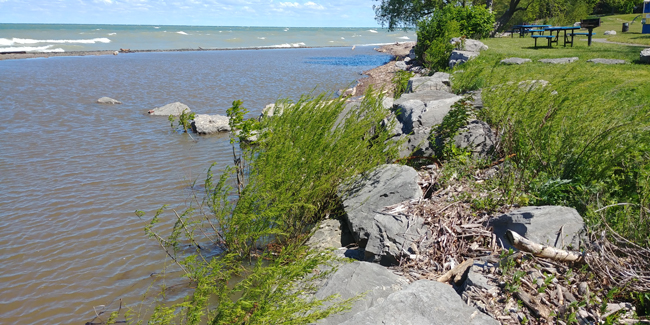— By Jessica Marinelli, Buffalo Rising
Buffalo, NY, June 23, 2021 - This free guide offers nature-based alternatives or improvements to traditional “gray” structures such as concrete seawalls, steel sheet piles, and rock rip-rap. Public and private property owners can use the guide to select the right plant for the right place to revitalize the state’s Great Lakes’ freshwater shorelines.
New York Sea Grant Coastal Hazards and Processes Specialist Roy Widrig authored the 24-page guide that includes a list of 41 species of trees, shrubs, grasses, ground covers, vines, and perennials with the preferred shoreline setting for each. Detailed photos and ideal growing conditions accompany each plant on the list.
“Reestablishing natural, stable shoreline slopes and transition zones from lake to upland areas rehabilitates habitat for native birds, fish, mammals, and insects while beautifying the waterfront, and it can aid in controlling shoreline erosion; and improve drainage and water quality,” says Widrig.

Cottonwood and willows, both water-loving species, help stabilize barrier beaches. Credit: Roy Widrig/New York Sea Grant.
The New York State Environmental Protection Fund under the New York Ocean and Great Lakes Ecosystem Conservation Act provided funding for this native plants publication. Funding through the New York State Department of Environmental Conservation will assist with publication distribution. Print copies will also be available by calling New York Sea Grant’s Oswego office at 315-312-3042.
More Info: New York Sea Grant
New York Sea Grant (NYSG), a cooperative program of Cornell University
and the State University of New York (SUNY), is one of 34 university-based
programs under the National Oceanic and Atmospheric Administration’s
National Sea Grant College Program.
Since 1971, NYSG has represented a statewide network of integrated
research, education and extension services promoting coastal community
economic vitality, environmental sustainability and citizen awareness
and understanding about the State’s marine and Great Lakes resources.
Through NYSG’s efforts, the combined talents of university scientists
and extension specialists help develop and transfer science-based
information to many coastal user groups—businesses and industries,
federal, state and local government decision-makers and agency managers,
educators, the media and the interested public.
The program maintains Great Lakes offices at Cornell University, SUNY
Buffalo, SUNY Oswego and the Wayne County Cooperative Extension office
in Newark. In the State's marine waters, NYSG has offices at Stony Brook
University in Long Island, Brooklyn College and Cornell Cooperative
Extension in NYC and Kingston in the Hudson Valley.
For updates on Sea Grant activities: www.nyseagrant.org has RSS, Facebook, Twitter, Instagram, and YouTube links. NYSG offers a free e-list sign up via www.nyseagrant.org/nycoastlines for its flagship publication, NY Coastlines/Currents, which is published quarterly.